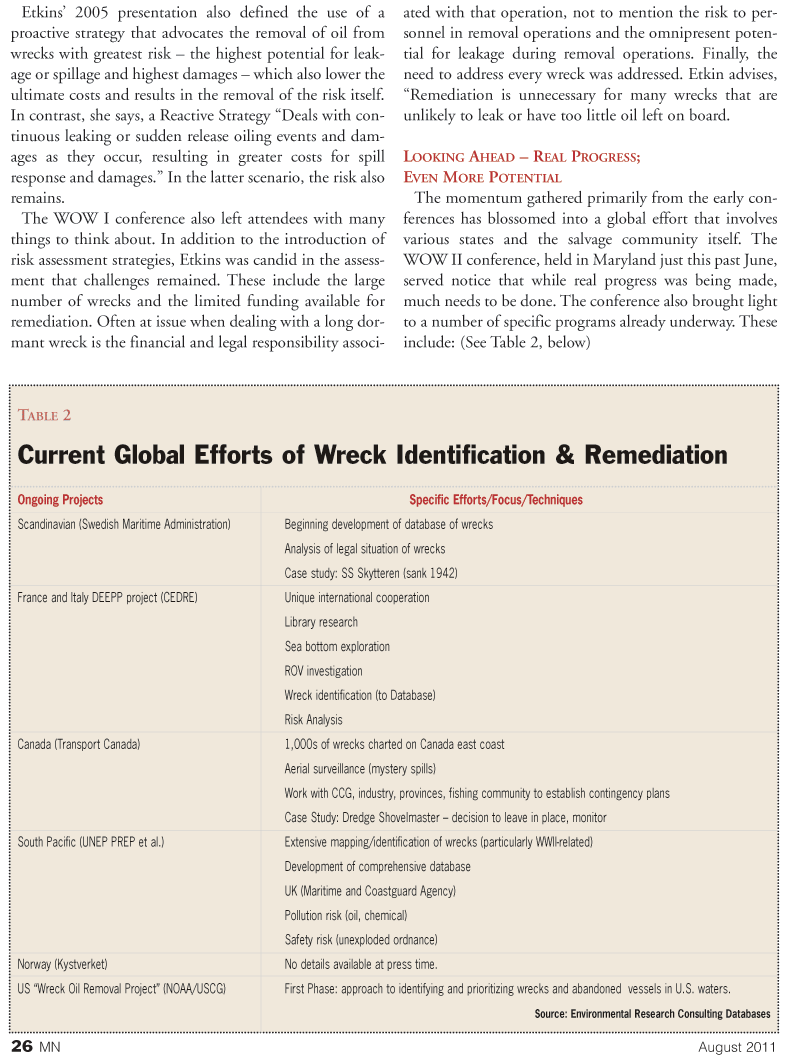
Page 26: of Marine News Magazine (August 2011)
Marine Salvage & Recovery Edition
Read this page in Pdf, Flash or Html5 edition of August 2011 Marine News Magazine
TABLE2Current Global Efforts of Wreck Identification & Remediation Ongoing ProjectsSpecific Efforts/Focus/Techniques Scandinavian (Swedish Maritime Administration)Beginning development of database of wrecks Analysis of legal situation of wrecks Case study: SS Skytteren (sank 1942) France and Italy DEEPP project (CEDRE)Unique international cooperation Library research Sea bottom explorationROV investigationWreck identification (to Database) Risk AnalysisCanada (Transport Canada)1,000s of wrecks charted on Canada east coast Aerial surveillance (mystery spills)Work with CCG, industry, provinces, fishing community to establish contingency plans Case Study: Dredge Shovelmaster ? decision to leave in place, monitor South Pacific (UNEP PREP et al.)Extensive mapping/identification of wrecks (particularly WWII-related) Development of comprehensive database UK (Maritime and Coastguard Agency) Pollution risk (oil, chemical)Safety risk (unexploded ordnance) Norway (Kystverket)No details available at press time. US Wreck Oil Removal Project? (NOAA/USCG)First Phase: approach to identifying and prioritizing wrecks and abandoned vessels i n U.S. waters.Source: Environmental Research Consulting Databases 26MNAugust 2011Etkins 2005 presentation also defined the use of a proactive strategy that advocates the removal of oil from wrecks with greatest risk ? the highest potential for leak- age or spillage and highest damages ? which also lower the ultimate costs and results in the removal of the risk itself. In contrast, she says, a Reactive Strategy Deals with con- tinuous leaking or sudden release oiling events and dam- ages as they occur, resulting in greater costs for spill response and damages.? In the latter scenario, the risk also remains. The WOW I conference also left attendees with many things to think about. In addition to the introduction of risk assessment strategies, Etkins was candid in the assess- ment that challenges remained. These include the large number of wrecks and the limited funding available for remediation. Often at issue when dealing with a long dor- mant wreck is the financial and legal responsibility associ- ated with that operation, not to mention the risk to per-sonnel in removal operations and the omnipresent poten- tial for leakage during removal operations. Finally, the need to address every wreck was addressed. Etkin advises, Remediation is unnecessary for many wrecks that are unlikely to leak or have too little oil left on board. LOOKINGAHEAD? REALPROGRESS ; EVENMOREPOTENTIAL The momentum gathered primarily from the early con- ferences has blossomed into a global effort that involves various states and the salvage community itself. The WOW II conference, held in Maryland just this past June, served notice that while real progress was being made, much needs to be done. The conference also brought light to a number of specific programs already underway. These include: (See Table 2, below)

 25
25

 27
27
